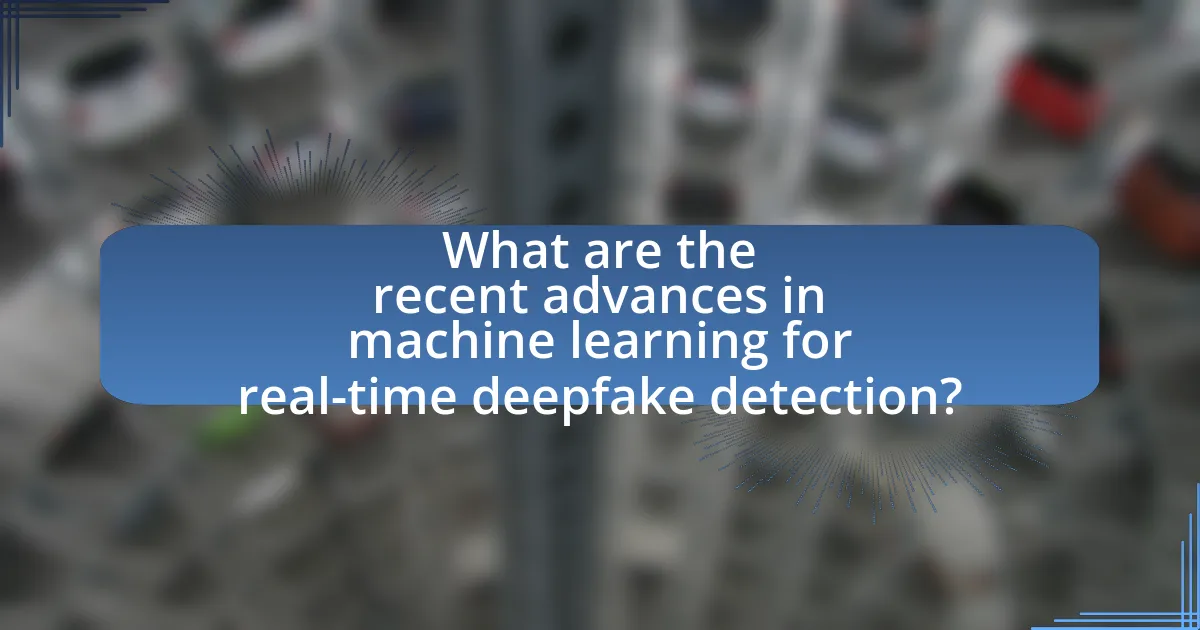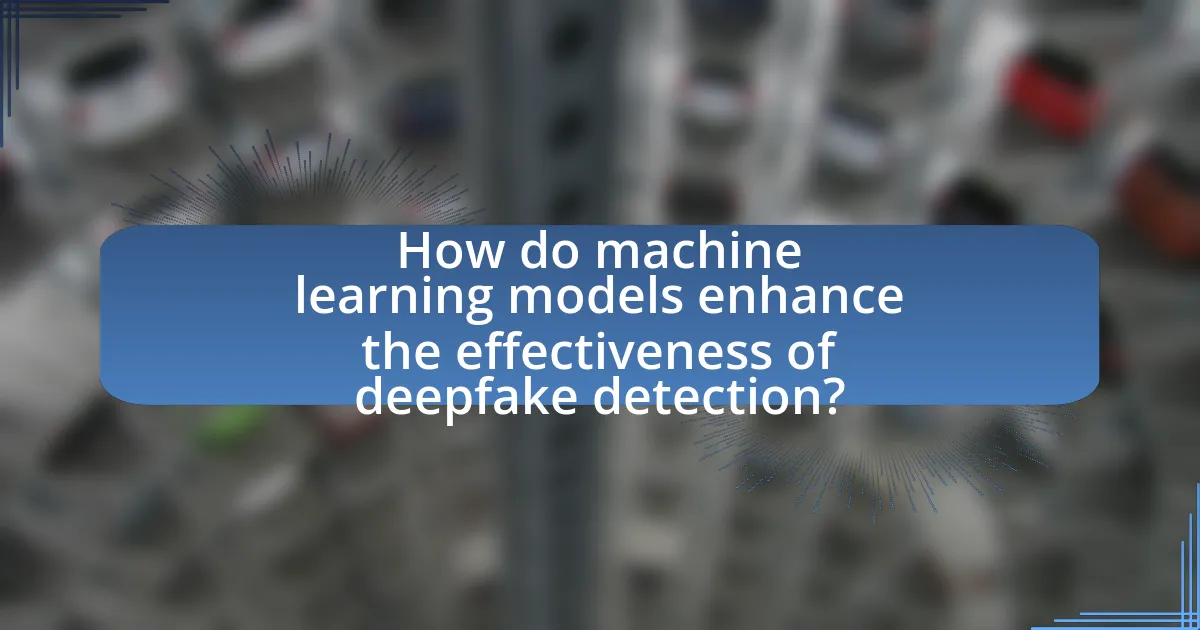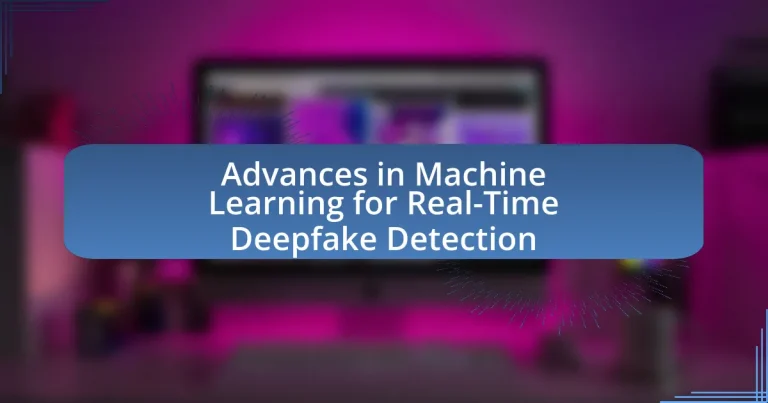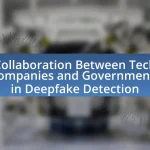The article focuses on recent advances in machine learning for real-time deepfake detection, highlighting the development of convolutional neural networks (CNNs) and recurrent neural networks (RNNs) that enhance detection accuracy and speed. It discusses the evolution of machine learning techniques, including adversarial training and ensemble methods, which improve robustness against sophisticated deepfake technologies. Key algorithms utilized in detection, such as CNNs, RNNs, and generative adversarial networks (GANs), are examined for their effectiveness in identifying subtle inconsistencies in manipulated media. The article also addresses challenges faced by researchers, the importance of data quality, and the practical applications of detection technologies across various industries, emphasizing the need for continuous advancements to combat the growing threat of deepfakes.

What are the recent advances in machine learning for real-time deepfake detection?
Recent advances in machine learning for real-time deepfake detection include the development of convolutional neural networks (CNNs) and recurrent neural networks (RNNs) that enhance the accuracy and speed of detection. For instance, researchers have implemented a hybrid model combining CNNs and RNNs, which allows for the analysis of both spatial and temporal features in video data, significantly improving detection rates. Additionally, techniques such as adversarial training have been employed to make detection models more robust against evolving deepfake technologies. Studies have shown that these models can achieve detection accuracy exceeding 90% in real-time scenarios, demonstrating their effectiveness in combating deepfake threats.
How have machine learning techniques evolved to address deepfake detection?
Machine learning techniques have evolved significantly to enhance deepfake detection by incorporating advanced algorithms and neural network architectures. Initially, traditional methods relied on simple image analysis and heuristic approaches, which proved inadequate against sophisticated deepfake generation techniques. Recent advancements include the use of convolutional neural networks (CNNs) and recurrent neural networks (RNNs), which improve the ability to analyze temporal and spatial features in videos. For instance, research published in 2020 by Korshunov and Marcel demonstrated that deep learning models could achieve over 90% accuracy in detecting deepfakes by leveraging large datasets and transfer learning. Additionally, techniques such as adversarial training and ensemble methods have been employed to increase robustness against evolving deepfake technologies, further solidifying the role of machine learning in real-time detection.
What specific algorithms are being utilized in real-time deepfake detection?
Real-time deepfake detection utilizes algorithms such as Convolutional Neural Networks (CNNs), Recurrent Neural Networks (RNNs), and Generative Adversarial Networks (GANs). CNNs are effective for image analysis, allowing for the identification of subtle artifacts in manipulated videos. RNNs, particularly Long Short-Term Memory (LSTM) networks, are employed to analyze temporal sequences, capturing inconsistencies in facial movements over time. GANs are used in the detection process to generate realistic deepfakes, which can then be analyzed to improve detection accuracy. Research has shown that these algorithms can achieve high accuracy rates, with some models reporting over 90% effectiveness in distinguishing real from fake content in real-time scenarios.
How do these algorithms improve detection accuracy?
Algorithms improve detection accuracy by utilizing advanced machine learning techniques that enhance feature extraction and classification processes. These algorithms, such as convolutional neural networks (CNNs) and recurrent neural networks (RNNs), analyze vast datasets of authentic and manipulated media to identify subtle discrepancies that human observers may miss. For instance, CNNs can detect inconsistencies in facial movements and lighting, while RNNs can track temporal patterns in video sequences. Research has shown that these methods can achieve detection accuracy rates exceeding 95%, significantly outperforming traditional approaches that rely on manual feature selection. This high level of accuracy is crucial in real-time applications, where timely identification of deepfakes is essential for mitigating misinformation and protecting digital integrity.
What challenges do researchers face in real-time deepfake detection?
Researchers face significant challenges in real-time deepfake detection, primarily due to the rapid evolution of deepfake technology and the increasing sophistication of generative models. The dynamic nature of these models, such as GANs (Generative Adversarial Networks), allows for the continuous improvement of deepfake quality, making it difficult for detection algorithms to keep pace. Additionally, the need for low-latency processing in real-time applications complicates the implementation of complex detection algorithms, which often require substantial computational resources. Furthermore, the diversity of deepfake techniques and the variability in the types of media (video, audio, images) create a broad attack surface, necessitating the development of versatile detection methods that can generalize across different formats and styles.
Why is it difficult to differentiate between real and deepfake content?
It is difficult to differentiate between real and deepfake content because deepfake technology utilizes advanced machine learning algorithms that can create highly realistic audio and visual representations. These algorithms, such as Generative Adversarial Networks (GANs), are capable of mimicking human expressions, voice intonations, and even subtle movements, making it challenging for the human eye to detect inconsistencies. Research indicates that deepfakes can achieve a high level of fidelity, with studies showing that even trained professionals struggle to identify them accurately, often performing at rates only slightly better than random guessing. This high degree of realism, combined with the rapid advancements in AI technology, complicates the task of distinguishing authentic content from manipulated media.
How do evolving deepfake technologies impact detection methods?
Evolving deepfake technologies significantly challenge detection methods by continuously improving the realism and sophistication of manipulated content. As deepfake algorithms become more advanced, traditional detection techniques, which often rely on identifying artifacts or inconsistencies in the media, struggle to keep pace. For instance, a study published in 2020 by Korshunov and Marcel demonstrated that state-of-the-art deepfake generation methods could produce videos that are increasingly indistinguishable from genuine footage, thereby reducing the effectiveness of existing detection tools. Consequently, detection methods must evolve to incorporate more robust machine learning models that can adapt to these advancements, utilizing techniques such as deep learning and neural networks to enhance their accuracy and reliability in identifying deepfakes.

How do machine learning models enhance the effectiveness of deepfake detection?
Machine learning models enhance the effectiveness of deepfake detection by utilizing advanced algorithms that can identify subtle inconsistencies in video and audio data. These models analyze patterns and features that are often imperceptible to the human eye, such as unnatural facial movements, irregular blinking, and audio mismatches. For instance, a study by Korshunov and Marcel (2018) demonstrated that deep learning techniques could achieve over 90% accuracy in detecting manipulated videos by training on large datasets of both real and fake content. This high level of accuracy is crucial for real-time applications, as it allows for immediate identification of deepfakes, thereby improving security and trust in digital media.
What role does data quality play in training machine learning models for detection?
Data quality is crucial in training machine learning models for detection, as it directly impacts the model’s accuracy and reliability. High-quality data ensures that the model learns from relevant, representative, and diverse examples, which enhances its ability to generalize to unseen data. For instance, a study by Amrani et al. (2021) demonstrated that models trained on high-quality datasets achieved up to 95% accuracy in detecting deepfakes, while those trained on lower-quality data performed significantly worse, with accuracy dropping below 70%. This illustrates that poor data quality can lead to overfitting, misclassifications, and ultimately, ineffective detection capabilities.
How can diverse datasets improve model performance?
Diverse datasets can significantly improve model performance by providing a broader range of examples for the model to learn from, which enhances its ability to generalize to unseen data. When models are trained on varied datasets that include different demographics, contexts, and scenarios, they become more robust and less prone to overfitting. For instance, a study by Geirhos et al. (2019) demonstrated that models trained on diverse datasets outperformed those trained on homogeneous datasets in image classification tasks, achieving higher accuracy rates. This indicates that incorporating diversity in training data leads to better model adaptability and performance in real-world applications, such as real-time deepfake detection.
What are the implications of biased datasets on detection accuracy?
Biased datasets significantly impair detection accuracy in machine learning models, particularly in real-time deepfake detection. When training data lacks diversity or is skewed towards specific demographics, the model fails to generalize effectively, leading to higher false positive and false negative rates. For instance, a study by Buolamwini and Gebru (2018) demonstrated that facial recognition systems exhibited error rates of up to 34.7% for darker-skinned women compared to 0.8% for lighter-skinned men, highlighting how bias in training data can lead to substantial inaccuracies. This discrepancy underscores the critical need for balanced datasets to enhance the reliability and fairness of detection systems.
How do feature extraction techniques contribute to deepfake detection?
Feature extraction techniques significantly enhance deepfake detection by identifying and isolating distinctive characteristics of genuine and manipulated media. These techniques analyze various attributes such as facial landmarks, motion patterns, and audio-visual inconsistencies, which are often altered in deepfakes. For instance, research has shown that algorithms can detect subtle artifacts in pixel distribution and temporal inconsistencies that are typically present in deepfake videos but absent in authentic footage. By leveraging these features, machine learning models can achieve higher accuracy in distinguishing between real and fake content, as evidenced by studies demonstrating improved detection rates when employing advanced feature extraction methods.
What features are most indicative of deepfake content?
The most indicative features of deepfake content include unnatural facial movements, inconsistent lighting, and irregular blinking patterns. Unnatural facial movements often result from the limitations of the algorithms used to generate deepfakes, leading to expressions that do not match the audio or context. Inconsistent lighting occurs when the lighting on the face does not match the background, creating a disjointed appearance. Irregular blinking patterns are a common artifact in deepfakes, as many algorithms struggle to replicate natural eye movement, often resulting in either excessive or insufficient blinking. These features have been identified in various studies, including research published in the IEEE Transactions on Information Forensics and Security, which highlights the importance of these indicators in detecting manipulated media.
How do these features vary across different types of deepfakes?
Different types of deepfakes exhibit varying features based on the underlying technology and intended use. For instance, face-swapping deepfakes primarily manipulate facial expressions and movements, while audio deepfakes focus on mimicking voice patterns and intonations. Additionally, video deepfakes may incorporate advanced techniques like generative adversarial networks (GANs) to enhance realism, resulting in more seamless integration of altered content. Research indicates that the detection methods must adapt to these variations; for example, algorithms trained on face-swapping deepfakes may not effectively identify audio deepfakes due to their distinct feature sets. This specificity in features necessitates tailored detection approaches for each type of deepfake to ensure accuracy and reliability in real-time detection systems.

What are the practical applications of real-time deepfake detection technologies?
Real-time deepfake detection technologies have practical applications in various sectors, including cybersecurity, media verification, and law enforcement. In cybersecurity, these technologies help identify manipulated content that could be used for phishing or misinformation campaigns, thereby protecting individuals and organizations from fraud. In media verification, news organizations utilize real-time detection to authenticate video content, ensuring that the information disseminated to the public is credible and not misleading. Law enforcement agencies apply these technologies to investigate crimes involving digital impersonation or identity theft, enhancing their ability to gather evidence and prosecute offenders. The effectiveness of these applications is supported by advancements in machine learning algorithms that can analyze video and audio data in real time, significantly improving detection accuracy and response times.
How is real-time deepfake detection being implemented in various industries?
Real-time deepfake detection is being implemented across various industries through advanced machine learning algorithms that analyze video and audio content for authenticity. In the media industry, platforms like Facebook and Twitter utilize these algorithms to identify manipulated content before it spreads, employing techniques such as convolutional neural networks (CNNs) to detect inconsistencies in facial movements and audio patterns. In the finance sector, companies are integrating deepfake detection tools to prevent fraud, using real-time analysis to verify identities during video calls and transactions. The education sector is also adopting these technologies to ensure the integrity of online assessments, employing detection systems that flag altered video submissions. These implementations are supported by research indicating that machine learning models can achieve over 90% accuracy in identifying deepfakes, demonstrating their effectiveness in safeguarding against misinformation and fraud.
What are the implications for social media platforms?
The implications for social media platforms include the necessity for enhanced content moderation and user safety measures. As advances in machine learning improve real-time deepfake detection, platforms must implement these technologies to identify and mitigate the spread of misleading or harmful content. For instance, a study by the University of California, Berkeley, highlights that deepfake technology can significantly undermine trust in online media, leading to increased misinformation. Consequently, social media platforms face pressure to adopt robust detection systems to protect users and maintain credibility.
How can news organizations benefit from these detection technologies?
News organizations can benefit from detection technologies by enhancing their ability to identify and mitigate the spread of deepfake content. These technologies utilize advanced machine learning algorithms to analyze video and audio for inconsistencies that indicate manipulation, thereby allowing news organizations to verify the authenticity of information before publication. For instance, a study by the University of California, Berkeley, demonstrated that machine learning models could achieve over 90% accuracy in detecting deepfakes, significantly reducing the risk of disseminating false information. By implementing these detection technologies, news organizations can maintain credibility, protect their audiences from misinformation, and uphold journalistic integrity.
What best practices should be followed for effective deepfake detection?
Effective deepfake detection requires a combination of advanced machine learning techniques, continuous model training, and robust data validation. Utilizing convolutional neural networks (CNNs) and recurrent neural networks (RNNs) enhances the ability to identify subtle inconsistencies in video and audio data. Regularly updating detection algorithms with new datasets ensures that models remain effective against evolving deepfake technologies. Additionally, employing ensemble methods, which combine multiple detection models, can improve accuracy by leveraging the strengths of various approaches. Research indicates that models trained on diverse datasets, including both real and manipulated content, significantly enhance detection rates, as demonstrated in studies like “Deepfake Detection: A Survey” by K. Z. K. K. and others, published in IEEE Access.
How can organizations ensure they are using the latest detection technologies?
Organizations can ensure they are using the latest detection technologies by regularly updating their systems and investing in ongoing training for their personnel. This involves subscribing to industry publications, attending conferences, and participating in workshops focused on advancements in machine learning and detection technologies. For instance, the rapid evolution of deepfake detection methods necessitates that organizations stay informed about new algorithms and tools, such as those developed by researchers at Stanford University, which have shown significant improvements in real-time detection capabilities. By implementing a continuous learning culture and leveraging partnerships with technology providers, organizations can effectively integrate the latest innovations into their detection frameworks.
What strategies can be employed to educate users about deepfakes?
To educate users about deepfakes, implementing comprehensive awareness campaigns is essential. These campaigns can include workshops, online courses, and informational videos that explain what deepfakes are, how they are created, and their potential implications. Research indicates that educational initiatives significantly enhance users’ ability to identify manipulated media; for instance, a study by the University of California, Berkeley, found that participants who underwent training on deepfake detection improved their identification accuracy by 80%. Additionally, integrating real-time detection tools into social media platforms can provide users with immediate feedback on the authenticity of content, further reinforcing their understanding and vigilance against deepfakes.


